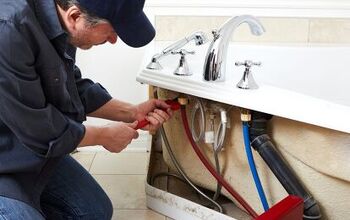Can A Toilet And Shower Share The Same Drain?

Depending on where you live, all of your drains will go to the main sewer line. However, do toilets and showers share the same drain? If you are handling a plumbing project, it is best to know this information beforehand.
A toilet and shower can share the same drain but they cannot share a waste trap arm for sanitary reasons. Both shower and toilet wastewater go to water treatment facilities, but shower water used to drain outdoors.
Below, we will get into why these drains are typically separate. We will also let you know how that answer changes from city to rural locations with septic tanks. We will also get into related topics.
Do You Need to Hire a Plumber?
Get free, zero-commitment quotes from pro contractors near you.

Greywater vs. Blackwater
The reason that we see these two different drains is related to the type of water. Water from your toilet has an additional potential to carry disease when compared to water coming from your toilet.
These differences are called grey water and black water, which we will be getting into below.
What Is Greywater?
Greywater comes from the shower. As you might imagine, it has less of an opportunity to carry disease than black water. Typically, the regulations behind its disposal are less stringent.
With greywater, the most critical aspect is that you cannot dispose of it in any drinking source. So you will want to be careful and avoid disposing of it in any rivers, streams, or lakes. In some cases, greywater can have a separate septic tank. This process occurs more often in homes away from city limits.
Some people still believe this type of water is suitable for watering your plants or washing your cars. But be careful about the number of chemicals you expose to your plants, as it can cause them to die.
What Is Blackwater?
Blackwater is on the other end of the spectrum. While you can feasibly find an excuse to use greywater, blackwater does not receive the same allowance. That is because it has feces and urine in it.
Any waste product that comes out of us is a severe vector for disease and sickness. We do not have the means to clean this water ourselves, so it needs to go to a sewage treatment facility. It is also wholly illegal to dispose of this water in any method that does not directly treat it. Dumping this in a lake or stream can result in intense fines and a possible arrest.
This type of water is the most common type of water to find in a septic tank. It is emptied at a sewage treatment facility when it is nearing full capacity.
Where Do I Dump My Blackwater Or Greywater Tank?
If you have a motor home, you can dispose of them at many RV parks, campgrounds, and dealerships. In some cases, you can also dispose of your wastewater at specific gas stations.
If you live in a fixed home, you will need to dispose of them at wastewater treatment plants or recycling centers. In some cases, you may have to drive to larger cities for disposal.
Try asking other friends in the area who have the same issue. They may be able to link you to local resources. If you find that they are disposing of their foul water improperly, you need to report them.
What Happens If There Is A Clog In The Sewer Line?
In either case, a clog in the sewer line will push air through the drain. As a result, you can smell the sewer in your own home and hear a gurgling noise. The contents will not typically come through the same drain. Instead, they come through the next available drain, which generally is the shower.
For example, flushing the toilet can cause your bath to smell like sewage.
When fixing it, start with a chemical cleaner like Drano. Most pipes can handle this, and the strong chemicals in here can get through most stubborn messes. If you are uncertain, check with the packaging on your chosen chemical cleaner. If the packaging isn’t specific, call your chosen company’s customer service line.
If this fails, you might wish to consider a drain snake. You can rent these from most hardware stores with relative ease. If you have never used one of these before, ask one of the specialists in the area.
Otherwise, you can follow these simple instructions on how to use a drain snake:
- Wear a pair of rubber gloves
- Remove the drain cover
- Push the drain snake into the available hole
- Keep going until you feel the blockage
- Rotate the drain snake until you feel the blockage give.
- Return the drain snake and place the gunk in an available trash can
If the gunk is too far down the sewer line, you will have to contact professional plumbers to handle this issue for you. Be sure to compare pricing and look at customer reviews.
Do You Need to Hire a Plumber?
Get free, zero-commitment quotes from pro contractors near you.

Related Questions
What If My Vent Stack Is Blocked?
If your efforts have yielded nothing and the sewage smell persists, the blockage is likely related to your vent stack. A vent stack is to remove the smell of the sewer from your house. It also balances pressure to make it easier for your water to drain. A vent stack is a pipe connected to your drain line that runs to the roof. Once you find it, take the vent stack off when it is not in use. Check to see if you can find any apparent physical blockages. The term “vent stack” is interchangeable with “plumbing vent.”
What Are Signs That The Plumbing Vent Is Clogged?
There are three typical signs that your plumbing vent is clogged:
- Sewer odor
- Gurgling noise
- Slow drain
If you are experiencing any signs, either contact a professional or follow the short guide below.
How To Unclog Vent Pipe On Roof?- Rent a plumber’s snake
- Run it through the pipe
- Begin to turn when you feel a blockage
- Go as far as you can
- Handle the remaining clogs with water from a garden hose
If you live in a location with colder temperatures, there is a fair chance your pipe is frozen. You can choose to dump a bucket of hot water down there, but be very careful on any frozen portion of your roof. You can also use a hose, but you need to be sure it can handle hot water.
Can A Toilet And Sink Share The Same Drain?It is more common for a toilet and a sink to share the same drain than the shower and the toilet. It is because most common bathrooms have the sink stuck in the middle.
This configuration is even preferable in more impoverished locations, as you produce more grey water in the shower. Avoid longer pipes if you plan on connecting a toilet and sink. You have a higher chance of clogs at a greater distance.
What Causes Toilets To Flush By Themselves?Phantom flushing, which is an actual thing, happens when your tank has a slow leak. At a certain point, the water level gets low enough to signal to the float that the tank needs refilling. Check to see if you have any web spots around your toilet. If not, there is a chance that your tank is leaking into your bowl. If there is water, you will need to turn it off and patch up the hole on the backside.
Next, you will want to check to see if all of the tank’s seals are nice and tight. There is a fair chance that this is the cause, as it can be pretty hard to miss a leak.
When you do make any replacements, be sure that you get the model number of your toilet. You want to be sure that you get parts that match your toilet’s needs.
Related Guides

I'm a guy who becomes the expert of whatever I stumble upon, writing-wise. I've written tons about cool home products, home improvement, and smart technology in the home. I'm also the proud father of a kiddo born on new years, making my holidays very busy.
More by Eli Smith











![How Much Weight Can a 4×4 Support Horizontally? [It Depends!]](https://cdn-fastly.upgradedhome.com/media/2023/07/31/9070333/how-much-weight-can-a-44-support-horizontally-it-depends.jpg?size=350x220)
![The 10 Best Table Saws - [2022 Reviews & Buyer's Guide]](https://cdn-fastly.upgradedhome.com/media/2023/07/31/9070645/the-10-best-table-saws-2022-reviews-buyer-s-guide.jpg?size=350x220)














